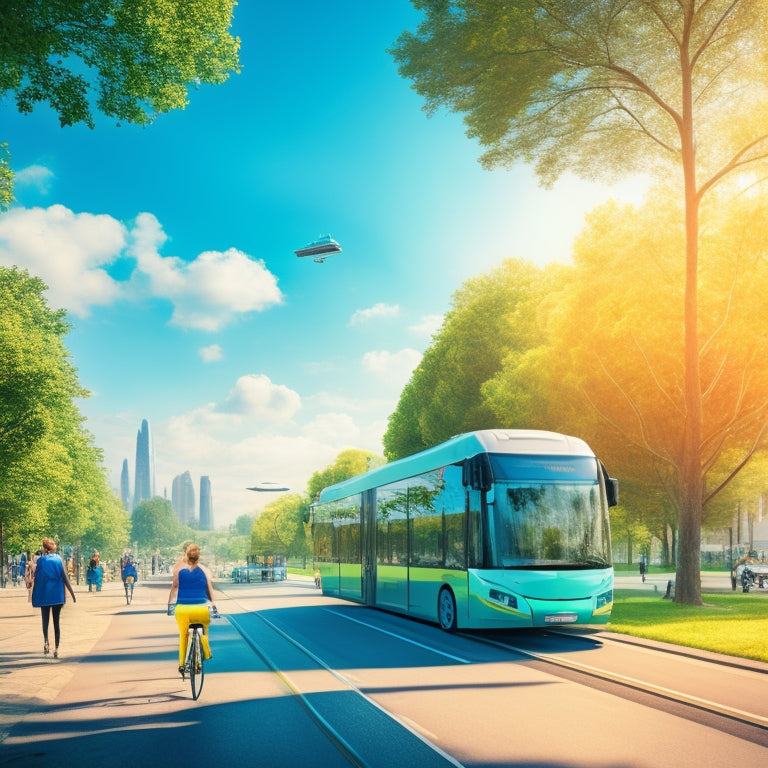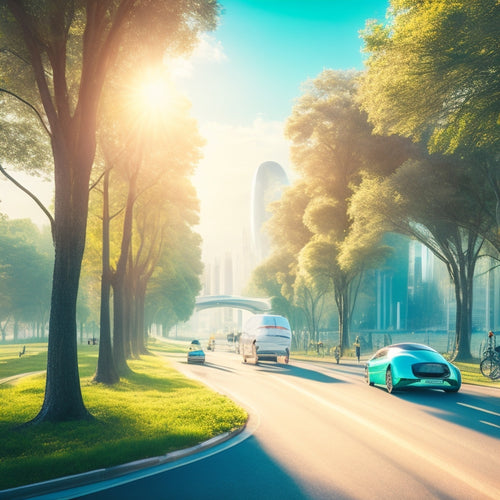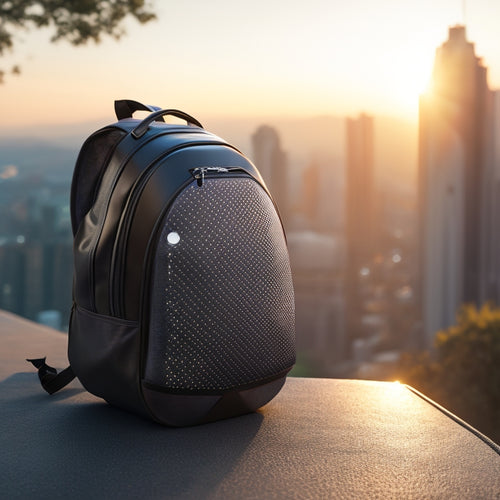
Sustainable City Transport Solutions for a Greener Future
Share
You're looking for a future where transportation and sustainability go hand-in-hand. You're not alone. Cities are transforming their transportation systems to reduce carbon footprints and enhance the quality of life. Electric vehicles, green public transportation, and bike-sharing initiatives are just the beginning. Autonomous vehicles, pedestrian-friendly urban planning, and smart traffic management systems are also key players in this revolution. As you explore these innovative solutions, you'll discover a future where transportation and sustainability converge, paving the way for a healthier planet and a better you - and that's just the starting point for a greener tomorrow.
Key Takeaways
• Strategically placed EV charging stations alleviate range anxiety and encourage adoption, driving a shift towards sustainable transportation.
• Green public transportation systems, such as eco-friendly buses and Bus Rapid Transit, reduce greenhouse gas emissions and enhance efficiency.
• Bike-sharing initiatives, accompanied by dedicated bike lanes, promote a healthier and more sustainable transportation culture, reducing traffic congestion and air pollution.
• Autonomous vehicle technology can create a safer and more efficient transportation system, but requires addressing job displacement concerns and cybersecurity risks.
• Pedestrian-friendly urban planning, featuring wide sidewalks, green spaces, and mixed land use, increases pedestrian safety, accessibility, and community engagement.
Electric Vehicle Infrastructure Development
As you navigate the pathway to sustainable city transport, developing a holistic electric vehicle (EV) infrastructure becomes an important step in accelerating the shift to eco-friendly transportation. You'll need to take into account the entire ecosystem, from EV charging stations to grid capacity, to guarantee a seamless shift.
Effective EV charging infrastructure is key, with strategically placed stations along highways, in urban centers, and at residential areas. This won't only alleviate range anxiety but also encourage widespread adoption.
However, it's vital to assess the impact of increased EV adoption on grid capacity. You'll need to analyze the electrical grid's ability to support the surge in demand, identifying areas that require upgrades or reinforcements. By doing so, you'll make sure that the electrical infrastructure can support the growing number of EVs on the road, preventing brownouts or blackouts.
Green Public Transportation Systems
Transforming your city's public transportation system into a green machine requires a multifaceted approach. One key aspect is integrating eco-friendly buses, such as electric or hybrid models, to greatly reduce greenhouse gas emissions and air pollution. Implementing Bus Rapid Transit (BRT) systems can further enhance efficiency and reduce congestion by dedicating bus lanes, introducing smart traffic signals, and optimizing routes to minimize travel times.
To boost the sustainability of your public transportation system, consider adopting Transit Oriented Development (TOD) principles. This strategy promotes mixed-use development around transit hubs, reducing reliance on personal vehicles and fostering walkable, bikeable communities. By embracing TOD principles, cities can not only cut emissions but also create more livable, people-centric urban environments.
Bike-Sharing Initiatives for Cities
By launching a bike-sharing initiative, you'll be putting wheels in motion to reduce traffic congestion, decrease air pollution, and promote a healthier, more sustainable transportation culture in your city.
As you design your bike-sharing system, prioritize the creation of dedicated bike lanes to guarantee a safe and efficient riding experience. This won't only encourage more people to opt for cycling but also reduce the risk of accidents.
Don't forget to emphasize helmet safety as an essential aspect of your initiative. By providing helmets with every bike rental, you'll be promoting a culture of safety and responsibility.
To make your initiative even more effective, consider integrating your bike-sharing system with existing public transportation networks. This will enable commuters to seamlessly switch between cycling and other modes of transport, making your city's transportation system more efficient and sustainable.
Autonomous Vehicle Technology Benefits
How will you harness the potential of autonomous vehicle technology to revolutionize your city's transportation landscape, improving safety, reducing traffic congestion, and enhancing the overall commuter experience?
By embracing autonomous vehicles, you'll create a safer, more efficient, and personalized transportation system. With human oversight, you'll mitigate cybersecurity risks and establish a seamless user experience. However, it's important to address job displacement concerns and explore new opportunities for workers in the autonomous era.
Rural access will improve, and vehicle customization will cater to diverse user needs. A robust supply chain will ensure a steady flow of components, while data ownership and insurance models will need to be reimagined.
As you integrate autonomous vehicles, be mindful of technology addiction and strike a balance between convenience and human connection. By doing so, you'll create a sustainable, efficient, and people-centric transportation system that benefits everyone.
Pedestrian-Friendly Urban Planning
As you redesign your city's infrastructure, you'll prioritize pedestrian-friendly urban planning, placing people at the heart of your transportation strategy. This approach not only promotes a healthier environment but also enhances the overall quality of life for citizens. By designing walkable neighborhoods, you'll encourage physical activity, reduce air pollution, and foster a sense of community.
| Design Element | Benefit |
|---|---|
| Wide sidewalks | Increased pedestrian safety and accessibility |
| Green spaces | Improved air quality and mental well-being |
| Mixed land use | Reduced need for personal vehicles, increased walkability |
| Limited traffic speed | Enhanced pedestrian safety and urban aesthetics |
| Public art installations | Enhanced urban aesthetics and community engagement |
Car-Sharing Services for Sustainability
You can reduce your reliance on personal vehicles and lower your carbon footprint by leveraging car-sharing services, which provide convenient access to transportation while minimizing the number of cars on the road. By sharing vehicles, you'll not only reduce traffic congestion but also decrease air pollution and greenhouse gas emissions. Car-sharing services promote fuel efficiency, as users tend to drive more responsibly and choose more environmentally friendly vehicles. Additionally, many car-sharing services offer hybrid or electric vehicles, further reducing emissions.
The user experience is also enhanced, as car-sharing services often provide a seamless booking and payment process, eliminating the need for car ownership hassles. With car-sharing, you can choose the right vehicle for your needs, from compact cars for city driving to SUVs for road trips. By sharing resources, you'll contribute to a more sustainable transportation system.
As the demand for sustainable transportation solutions grows, car-sharing services will continue to play an important role in shaping the future of urban mobility.
Electric Scooter Safety Regulations
Cities must establish and enforce stringent electric scooter safety regulations to mitigate the risks associated with their increasing popularity. As you navigate the city on an electric scooter, you expect a safe and enjoyable ride. However, the rising number of accidents and injuries has raised concerns about the lack of regulations. To address this, cities can implement measures such as helmet laws, rider training, and designated scooter lanes.
| Safety Measure | Description | Implementation |
| Helmet Laws | Mandatory helmet use for riders | Enforceable fines for non-compliance |
| Rider Training | Compulsory training for new riders | Online or in-person training sessions |
| Designated Lanes | Dedicated lanes for electric scooters | Marked lanes with clear signage |
| Speed Limits | Maximum speed limits for electric scooters | Enforceable fines for exceeding limits |
| Insurance Requirements | Mandatory insurance for riders | Proof of insurance required for scooter rental |
Urban Planning for Green Spaces
When envisioning a sustainable transportation system, you'll need to contemplate how urban planning can incorporate green spaces that benefit both citizens and the environment.
You'll want to explore ways to integrate green infrastructure, restore urban forests, and revitalize public parks, ultimately creating a more livable and resilient city.
Green Infrastructure Integration
By strategically incorporating green spaces into urban planning, municipalities can mitigate the urban heat island effect, improve air quality, and enhance biodiversity, ultimately fostering more resilient and livable cities.
As you envision a greener future, you'll want to prioritize green infrastructure integration. This involves incorporating urban forestry and green corridors into your city's design. Urban forestry, for instance, can help reduce air pollution, absorb carbon dioxide, and provide shade.
Green corridors, on the other hand, can connect fragmented habitats, promoting ecological connectivity and supporting local wildlife. By integrating these green spaces, you'll create a more sustainable, resilient, and healthier urban environment.
Urban Forest Restoration
What role can urban forest restoration play in revitalizing underutilized or neglected spaces, and how can strategic planning help you harness the full potential of these areas to enhance your city's ecological footprint?
By integrating tree canopy expansion and soil remediation into your urban planning, you can reveal the hidden potential of these spaces. Urban forest restoration not only beautifies the area but also provides numerous ecological benefits. It improves air quality, reduces urban heat islands, and supports local biodiversity. Additionally, it increases property values, enhances community engagement, and fosters a sense of place.
To maximize the impact, collaborate with local stakeholders to identify areas of need and develop a tailored restoration plan. Consider incorporating native species, implementing sustainable maintenance practices, and engaging the community in the restoration process. By doing so, you'll be creating a thriving urban ecosystem that benefits both people and the environment.
Public Park Revitalization
You can transform underutilized public parks into vibrant green spaces that foster community engagement and environmental sustainability by incorporating innovative urban planning strategies. By doing so, you'll not only revitalize neglected areas but also create hubs for community interaction, recreation, and education.
Public park revitalization is a critical component of urban revitalization, as it enhances the quality of life for residents, promotes eco-friendly practices, and boosts local economies.
To achieve this, you'll need to engage with the community, identifying their needs and aspirations for the park. This collaborative approach guarantees that the revitalized space meets the community's unique requirements, fostering a sense of ownership and responsibility.
Incorporating green infrastructure, such as rain gardens, green roofs, and permeable pavements, will also help to mitigate urban environmental challenges like stormwater runoff and urban heat islands.
Smart Traffic Management Systems
Cities utilizing smart traffic management systems can greatly reduce congestion, decrease travel times, and minimize environmental impact by optimizing traffic signal control, route planning, and real-time traffic monitoring. As you navigate through the city, you'll notice the seamless integration of technology and infrastructure, working together to make your commute smoother and more efficient.
Traffic analytics play a significant role in this process, providing valuable insights into traffic patterns and trends. By analyzing this data, city planners can identify areas of improvement and implement targeted solutions to alleviate congestion hotspots. Real-time monitoring also enables city officials to respond promptly to incidents, minimizing disruptions and keeping traffic flowing.
As you explore the city, you'll see how smart traffic management systems are revolutionizing the way we travel. With optimized traffic signal control, you'll experience fewer stops and starts, reducing emissions and air pollution. You'll also notice that traffic lights are synchronized to optimize traffic flow, reducing congestion and decreasing travel times.
Frequently Asked Questions
How Can Cities Balance Bike Lanes With Limited Urban Space?
As you navigate urban planning, you'll need to prioritize bike infrastructure, like cycle highways, and consider road diets, lane sharing, and space efficiency to balance bike lanes with limited urban space.
Will Autonomous Vehicles Replace Human-Driven Public Transport?
As you ponder the role of autonomous vehicles in public transport, consider the benefits of Autonomous Hubs, improved Vehicle Safety, and potential Public Acceptance, but also weigh Job Displacement concerns and efficient Fleet Management strategies.
Can Green Roofs on Buses Improve Urban Air Quality Significantly?
As you explore innovative solutions, consider that cleverly chosen vegetation on bus roofs can greatly enhance air quality, but it's essential to balance vegetation selection with air filtration, roof maintenance, and clever bus design to maximize urban forestry benefits.
Do Car-Sharing Services Reduce Overall Car Ownership Rates?
As you explore car-sharing services, you'll find they indeed reduce overall car ownership rates by altering car usage patterns and mobility behavior, offering users flexibility and convenience, ultimately leading to a shift towards more sustainable transportation habits.
What Percentage of Urban Land Should Be Reserved for Green Spaces?
As you envision the perfect urban oasis, you'll want to reserve at least 30% of land for green spaces, incorporating green corridors that connect parks, improving air quality and residents' well-being, while fostering a sense of community.
Related Posts
-

Why Portable Solar Panels Are a Car Owner's Best Friend
As a car owner, you're likely no stranger to the frustration of a dead battery or a dwindling power supply on a long ...
-

Why Eco-Friendly Rides Are the Future of Commuting
As you seek alternatives to traditional vehicles, you'll find eco-friendly rides are not only convenient and cost-eff...
-

Charging On-The-Go: Portable Battery Solutions Online
You're always on the move, and your devices need to keep up - that's why having a reliable portable battery solution ...


